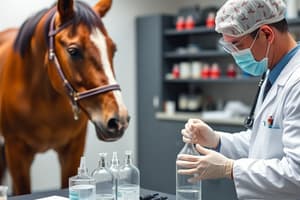Podcast
Questions and Answers
What is the significance of the presence of sloughed epithelial cells and necrotic cellular debris in the renal cortex and medulla?
What is the significance of the presence of sloughed epithelial cells and necrotic cellular debris in the renal cortex and medulla?
- Indicates acute renal failure due to ischemia (correct)
- Points towards a postmortem artifact
- Suggests chronic renal impairment
- Represents normal renal physiology
What histopathologic finding is characterized by highlighted orange to orange-red tubular casts?
What histopathologic finding is characterized by highlighted orange to orange-red tubular casts?
- Cholestasis
- Hemoglobinuria (correct)
- Proteinuria
- Glomerulonephritis
Which feature indicates the presence of intraluminal mineralization in renal tubules?
Which feature indicates the presence of intraluminal mineralization in renal tubules?
- Granular casts
- Scattered mineral deposits (correct)
- Sloughed epithelial cells
- Hyaline casts
What is indicative of mild ectasia in renal tubules?
What is indicative of mild ectasia in renal tubules?
What does hypereosinophilic cytoplasm in centrilobular to midzonal hepatocytes indicate?
What does hypereosinophilic cytoplasm in centrilobular to midzonal hepatocytes indicate?
What is the most likely cause of the elevated levels of lactate observed in the referral DVM data?
What is the most likely cause of the elevated levels of lactate observed in the referral DVM data?
What does the renal necropsy findings suggest about the state of the kidneys in this equine case?
What does the renal necropsy findings suggest about the state of the kidneys in this equine case?
Which parameter exceeded the reference range indicating a potential health crisis in the gelding?
Which parameter exceeded the reference range indicating a potential health crisis in the gelding?
In the context of acute colic in the pony, what role does elevated creatinine kinase (CK) levels play?
In the context of acute colic in the pony, what role does elevated creatinine kinase (CK) levels play?
What histological change is most likely seen in the renal tissue of the pony associated with hemoglobinuric nephrosis?
What histological change is most likely seen in the renal tissue of the pony associated with hemoglobinuric nephrosis?
What was the PCV of the pony on October 16, 2020?
What was the PCV of the pony on October 16, 2020?
What marked biochemical change was observed alongside the pony's declining health?
What marked biochemical change was observed alongside the pony's declining health?
What was the measured respiratory rate of the pony upon presentation at the veterinary hospital?
What was the measured respiratory rate of the pony upon presentation at the veterinary hospital?
What condition did the laboratory results on presentation suggest regarding the pony's kidney function?
What condition did the laboratory results on presentation suggest regarding the pony's kidney function?
What critical change occurred in the pony's lactate levels during the night before referral?
What critical change occurred in the pony's lactate levels during the night before referral?
What was the primary treatment administered to the horse to address severe electrolyte derangement?
What was the primary treatment administered to the horse to address severe electrolyte derangement?
What condition was indicated by the dark red urine observed in the horse?
What condition was indicated by the dark red urine observed in the horse?
What outcome occurred after the treatment and hospitalization of the horse?
What outcome occurred after the treatment and hospitalization of the horse?
What was a significant finding during the postmortem examination of the horse?
What was a significant finding during the postmortem examination of the horse?
During hospitalization, what was the duration of treatment for the pony with acute colic?
During hospitalization, what was the duration of treatment for the pony with acute colic?
Flashcards are hidden until you start studying
Study Notes
Clinical Presentation
- A 14-year-old, 200-kg Dartmoor pony gelding presented with acute colic.
- The pony was down for 2 days and had a history of being down with acute colic.
- The pony presented with a diffuse brown discoloration of all internal organs.
- The kidneys were swollen with a red to brown discoloration of the renal cortex and medulla.
- The cortex displayed multifocal dark red radial streaks extending to the capsular surface.
- The medulla was diffusely red with irregular dark red patchy areas and yellow discoloration of renal pelvis adipose tissue.
- A small amount of dark red urine was obtained.
Laboratory Findings
- Serum biochemistry profile revealed significant abnormalities:
- Increased Lactate (>12 mmol/L)
- Moderate Bilirubin (no value given)
- Increased Glucose (191 mg/dL)
- Increased BUN (25 mg/dL)
- Markedly Increased AST (670 IU/L)
- Markedly Increased CK (1191 IU/L)
- Increased Potassium (3.6 mmol/L)
Histopathology
-
Renal Tubules:
- Contained brightly eosinophilic to red, hyaline to granular material (hemoglobin and hyaline casts)
- Occasionally mixed with sloughed epithelial cells and necrotic debris (granular casts)
- Tubules exhibited mild ectasia with attenuated epithelium.
- Sloughed epithelial cells with karyorrhectic and pyknotic nuclei, hypereosinophilic cytoplasm (necrosis), and fragmentation of tubular basement membranes (tubulorrhexis).
- Scattered renal tubules showed intraluminal mineralization.
- Orange to orange-red tubular casts confirmed the presence of hemoglobin.
-
Hepatic Parenchyma:
- Portal tracts contained mildly expanded mature fibrosis and scattered lymphocyte infiltration.
- Centrilobular to midzonal hepatocytes had expanded swollen cytoplasm containing microvesicular lipid vacuoles.
Treatment
- Fluids with dextrose and calcium were administered to lower potassium levels and protect the heart from severe electrolyte derangement.
Outcome
- The pony experienced seizures despite treatment and eventually died naturally.
Diagnosis
-
Hemoglobinuric nephrosis: This is a renal condition that affects the tubules and is characterized by the presence of hemoglobin in the urine.
- The presence of hemoglobin casts in the renal tubules, sloughed epithelial cells, and necrotic cellular debris strongly supports the diagnosis.
- The characteristic diffuse red-brown discoloration is due to the presence of hemoglobin in the renal cortex and medulla.
- The multifocal radial streaks and patchy areas seen in the renal cortex and medulla are also consistent with hemoglobinuric nephrosis.
-
The presence of microvascular fat in the liver suggests a potential association with fatty liver disease as a contributing factor.
-
The presence of increased BUN and AST indicates renal dysfunction and possible liver involvement.
-
The increased lactate levels indicate potential tissue hypoxia and metabolic acidosis, which may have contributed to the seizures.
-
The increased potassium and bilirubin levels suggest potential renal and liver dysfunction.
Differential Diagnoses
- Acute renal failure
- Hypovolemic shock: This is a life-threatening condition that arises from a shortage of blood volume in the circulatory system. It can result from a variety of causes, including dehydration, blood loss (hemorrhage), plasma loss (burns), and third spacing of fluids in the space between cells.
- Sepsis: This is a potentially life-threatening condition in which the body’s immune system is overwhelmed by a bacterial or fungal infection.
- Acute tubular necrosis: This is a common cause of acute kidney injury (AKI).
- Hemolytic anemia:
- This condition is characterized by the premature destruction of erythrocytes (red blood cells).
- Hemolytic anemia can lead to hemoglobinuria, a condition in which hemoglobin is released into the urine.
- Lead poisoning: This is a serious condition that can affect multiple organs, including the kidneys.
Conclusion
- This case highlights the importance of recognizing and treating acute renal failure in horses.
- Early diagnosis and intervention are crucial for improving patient outcomes.
Red Maple Toxicity in a Dartmoor Pony
- A 14-year-old Dartmoor pony presented with acute colic, moderate anemia (PCV 20%), hyperlactatemia (12 mmol/L), and hyperbilirubinemia.
- The pony initially showed improvement with decreased lactate levels (3.3 mmol/L) but then declined again, exhibiting pipe stream diarrhea and anuria.
- Blood gas analysis revealed hyperkalemia (7.7 mmol/L), elevated lactate (> 15 mmol/L), hypoglycemia (17 mg/dL), elevated AST (541 IU/L), and CK (1,779 IU/L).
- These findings suggested anuric renal failure.
- Postmortem examination revealed diffuse brown discoloration in all internal organs, multifocal dark red radial streaks in the renal cortices, diffusely red medullae with irregular dark red patchy areas, and yellow discoloration in the adipose tissue in each renal pelvis.
- Microscopic examination showed hyaline to granular material (hemoglobin and hyaline casts) within renal tubules, sloughed epithelial cells, necrotic debris (granular cast), tubular ectasia, attenuated epithelium, sloughed epithelial cells with karyorrhectic and pyknotic nuclei, hypereosinophilic cytoplasm, fragmentation of tubular basement membranes (tubulorrhexis), and scattered intratubular mineralization.
- Hemoglobin casts were confirmed by Okajima stain.
- The liver exhibited portal tract fibrosis, lymphocyte infiltration, expanded swollen cytoplasm with microvesicular lipid vacuoles in centrilobular to midzonal hepatocytes.
- Red maple toxicity is often seen in the fall or early spring when fallen leaves are uncovered.
- The disease develops with the consumption of partially decayed or dead leaves.
- Consumption of 0.5% to 0.8% of body weight or 1.5 to 3.0 g/kg of dry leaves can cause intoxication. Estimated fatality rate over 60%.
- The exact toxin is unknown but is hypothesized to be a nitrogenous compound, gallic acid, or polyphenol.
- Dead leaves generate potent oxidants that overcome the glutathione-reducing system in red blood cells leading to Heinz body formation.
- Heinz bodies weaken the red blood cell membrane, leading to osmotic lysis and hemoglobin release (hemoglobinemia).
- Hemoglobinuria develops when the renal reabsorption threshold for hemoglobin is exceeded.
- The proximal tubule and renal medulla are highly metabolic and sensitive to decreased oxygenation.
- The oxidation of free hemoglobin to methemoglobin further exacerbates oxygen delivery.
- Reduced oxygen-carrying capacity leads to shock and renal nephrosis.
- Pooled hemoglobin casts within tubules can block the tubules leading to obstruction and further tubular necrosis.
- Differential diagnoses include leptospirosis, babesiosis, exertional rhabdomyolysis, end-stage liver disease, equine infectious anemia, and red maple toxicity.
- Diagnosis relies on clinical testing for hemolysis and methemoglobinemia, a good clinical history, and ruling out other etiologies with laboratory testing.
- Treatment of red maple toxicity is rarely successful due to the rapid clinical course and unknown toxin.
- Therapy focuses on palliative care and addressing sequelae of hemolysis.
- Blood transfusions, colloidal fluids, fluid therapy, activated charcoal (if timely), mineral oil, non-steroidal anti-inflammatory drugs, and corticosteroids have been described with varying outcomes.
- Methylene blue is considered non-efficacious and may even worsen the condition.
- Ascorbic acid (vitamin C) has shown promise in reducing methemoglobin.
Studying That Suits You
Use AI to generate personalized quizzes and flashcards to suit your learning preferences.




